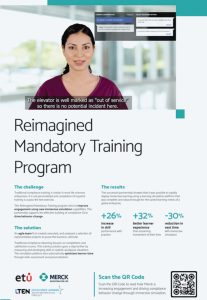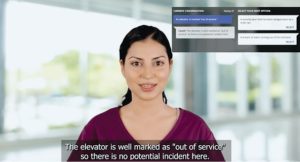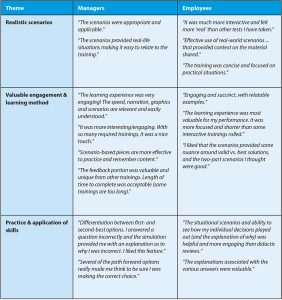COVER STORY – By Theresa Zeller, Jennifer Iannetta and Dr. Declan Dagger
Immersive learning helped Merck rethink mandatory training
 How do you make life sciences training engaging, optimized and effective? How do you capture the attention of more than 68,000 employees located in every region of the world and transform behavior? Merck, a global biopharmaceutical company, approached ETU, a provider of learning simulation platforms, to help bring their compliance messages home to employees.
How do you make life sciences training engaging, optimized and effective? How do you capture the attention of more than 68,000 employees located in every region of the world and transform behavior? Merck, a global biopharmaceutical company, approached ETU, a provider of learning simulation platforms, to help bring their compliance messages home to employees.
Each year, Merck delivers approximately 237,000 hours of enterprise mandatory training annually across the 68,000+ employees in addition to approximately 480,000 hours of localized mandatory training.
As training is essential to enterprise success, Merck sought to reengineer this development area globally through its “Reimagine Mandatory Training” program to improve engagement, shift from awareness to deeper focus on behavior change and optimize learning time through innovation. The goal was to build compliance IQ to empower the Merck workforce to make compliant decisions daily.
Merck delivered on that promise through immersive learning built on a learning simulation platform that proves out the rigorous business rationale for reimagined mandatory training.
What They’re Saying About the Incident Escalation Simulation
Why Reimagine Learning?
As an organization, Merck chose to move away from traditional “click-next” elearning typically found in compliance training. The reasons were many: Traditional elearning doesn’t acknowledge what a learner already knows. In fact, it assumes the learner knows nothing.
Traditional elearning is not personalized and is assigned to all employees (or by role) without considering an employee’s acumen and experience. While refreshers can be an important part of learning, for more tenured employees, repeated learning at the foundational level isn’t challenging and doesn’t allow them to grow further; it’s just frustrating.
To many employees, traditional elearning is also cumbersome — another “to do” item in their inbox, competing for their time. Lastly, completion of mandatory training as a pass-the-test exercise doesn’t add value to the organization because it has little to do with skill or application improvement.
Immersive learning, on the other hand, puts a learner into a real-life work scenario and allows them to see the impact of their response. It pinpoints where the learner has gaps in knowledge or skills. Equally important, it provides a safe place where the learner can course-correct their decisions in private, without judgment from peers or managers.
Further, immersive learning provides rich data by delineating trends and the number of attempts to demonstrate skills optimally as employees work through decisions. Data also reveals common mistakes, which can be shown to business stakeholders to point out where the population of employees is succeeding and where they are struggling. This data allows the learning and development team to be more precise in recommendations as to where learning can be of most value.
Why did Merck choose to dive into immersive learning today? What makes immersive learning so attractive to employees now? Because of the pandemic, there is more of a mindset that you don’t have to be in a classroom or office to learn, making it an opportune time for Merck to bring technology into a learning experience — especially when you consider Merck, who at the onset of the pandemic was in the midst of reevaluating the learning technology ecosystem, opening the door to how they could use technology differently. Merck had a strong history with ETU, having worked with ETU on prior “proofs of value” in soft skills and technical skills as well as at least one ETU off-the-shelf simulation. Reimaging Mandatory Training for compliance was a natural next step for their partnership.
The ‘Reimagined’ Approach
What exactly was the business case for the Reimagine Mandatory Training program? The key business objectives were to:
- Increase engagement using new immersive simulation capabilities.
- Drive behavior change through the development of compliance IQ.
- Optimize learner time through skills assessment and personalization.
To realize these capabilities, Merck wanted the program to be:
- Relevant to the learner, using real-life scenarios so that learners know how to respond when faced with similar on-the job situations.
- Focused on behavior, addressing critical skills and objectively measuring skills and behaviors in context.
- Continuous and timely, closer to the flow of work and shorter in duration for those demonstrating required skills.
- A safe space to make mistakes and get real-time feedback to improve — a judgment-free environment for learning.
The partners approached this program in an agile way. New innovations in learning were rapidly tested as minimal viable products (MVP), and the resulting data was then analyzed to make decisions on how to improve the MVP and scale worldwide. The agile team included a product owner, internal architects, designers, developers and project manager from Merck.
How do the simulations work? They measure learning transfer and improvements through the Measure > Learn> Perform cycle.
The journey to closing skill gaps begins with measurement. If learners don’t pass, they’re directed to learning assets that will help close the gaps. The platform automatically adapts to learners of different skill levels with the testing and remediation cycle until the learner’s performance meets the success criteria.
The platform automatically provides skills scores to stakeholders. The analytics includes tracking over time to show improvements. All users can access the simulations without special hardware. No virtual reality headsets are needed, and the digital solution is scalable to all relevant employees. As for how the simulations perform the numbers speak for themselves.
Proof of Values
Beginning in 2019 and through 2020, the partners worked on soft skills and aseptic mindsets and techniques. Aseptic can be defined as the state of being free from disease-causing microorganisms through facility practices.
Before partnering with ETU, Merck new hires and employees in one manufacturing site received aseptic mindset training ETU and Merck built a simulation to develop the skills necessary to manufacture in cleanrooms. Since lost batches are costly for the business, there was a strong business case for the aseptic mindset simulation. The results were outstanding:
- 12-minute simulation gives learners time back in the day, compared to the previous three-hour elearning and classroom course.
- 15 times faster to train with immersive simulation than instructor-led training.
- Increased learner performance scores — an average +21% for critical skills that mitigate risk.
- Errors reduced by 97% in a simulated environment, mitigating potential risks on the job.
Incident Escalation: Results
Just as in the proof of values, Merck saw great success with the first mandatory training simulation MVP, incident escalation. There were two simulations — one for employees, one for managers. The innovative application of immersive simulation saw an average +26% improvement in skill performance through the training. Common decision errors were identified and remediated in the moment through the simulation platform.
The simulation exceeded expectations on all three business objectives/key performance indicators, including improving behavior and comprehension. Learners received real-time feedback by a coach on why their choice wasn’t the optimal selection. When end users were asked about their experience, they expressed that it was 32% higher in value than previous elearning experiences.
The MVP Incident Escalation program was ultimately released to 20,000 employees in the U.S. As Merck expands its immersive training in other mandatory areas, they expect to optimize seat time and drive a 20% reduction to current spend on enterprise mandatory training while maintaining quality of experience, adherence to their employee risk mitigation plans and increasing the ability to ensure behavior change.
Lessons Learned
The bottom line? The successful partnership with Merck showed that it was possible to rapidly develop and deploy simulation-based learning — and that the technology platform was complete and robust enough for the needs of a global life sciences organization.
Immersive simulations now enable Merck to scale skill measurement and development — employees can practice and apply new behaviors at scale. The new behavioral data enables Merck to identify and prioritize risk areas. The team also learned that there were core skills and behaviors that were very applicable to wider compliance topics, e.g., situational awareness.
The team has now created “The Mandatory Training Master Blueprint,” a guide for designing engaging, effective learning experiences for skills and behaviors in the mandatory training area. New projects will begin with this blueprint when architecting and designing learning experiences related to mandatory training to achieve a cohesive, integrated learning experience regardless of role or function. The team intends to continue to iterate and improve on the core model to giveback time to employees and focus on improving compliance IQ in a meaningful, relevant way for its employees.
As the simulations generated very rich data and analytics, Merck stakeholders can now make more well-informed decisions on behalf of its people, but also on how L&D invests the company’s time and money. The key is to identify those metrics and measures from the beginning, which was done on each project.
Plans are now in place to localize the simulations to more than 20 languages. Platform upgrades will optimize the localization process to ensure it can be deployed globally. Merck is now in advanced discussions on how to apply advanced personalization to the program.
Theresa Zeller is global head of integrated learning experiences at Merck. Jennifer Iannetta is lead learning architect at Merck. Dr. Declan Dagger is chief operating officer for ETU.










